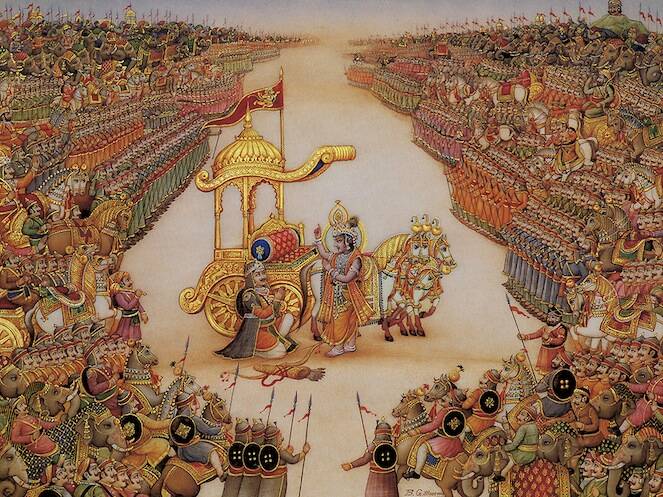Cambridge, MA. I doubt if you are holding your breath, but at the end of my last posting, on Jesus’ transformative encounter with a leper in Mark 1, I mentioned that I would be blogging on the Bhagavad Gita during Lent. Now we are a week into Lent, so I had better start. The idea came to me while commenting on Mark 1, since the Gita too tells the story of a man in trouble who rises up renewed to his mission. The warrior Arjuna was led from despondency and spiritual paralysis to action, as the leper, cured, rose up, and on his own started to preach boldly of what Jesus had done for him. Krishna, his divine chariot driver, teaches Arjuna of detachment, self-knowledge, duty according to tradition, doing what is right without care for the fruits of one’s actions, participation in God’s selfless and detached action in the world, utter devotion to that Lord in one’s actions. The words sink into Arjuna; he sees Krishna in his divine totality.
So I will try to figure out with you how the Gita is relevant to Christians during Lent. (If you are not familiar with the Gita, there are innumerable translations available; two old but reliable ones are free online: Edwin Arnold’s (much appreciated by Gandhi early in his study), and that of Kashinath Trimbak Telang, in the Sacred Books of the East. You can also see in Peter Brook’s stage play and movie version of the Mahabharatathe a brilliant visual summary of the Gita, about 10 minutes long.
The easiest point of entry, perhaps, is another Gospel text, for the first Sunday of Lent this year, Mark 1:12-14. Jesus had already been baptized by John but just then, as he seems ready to take up his mission, he is pulled away, driven into the desert by the Spirit.
And the Spirit immediately drove him out into the wilderness. He was in the wilderness for forty days, tempted by Satan; and he was with the wild beasts; and the angels waited on him.
After some kind of spiritual contest amid nature’s raw realities, he is able to take up his mission with energy and intensity:
Now after John was arrested, Jesus came to Galilee, proclaiming the good news of God, saying, ‘The time is fulfilled, and the kingdom of God has come near; repent, and believe in the good news.’ (Mark 1:12-14)
Jesus thus moves quickly from his private life, to the Jordan, to the desert, to a very public ministry from which there is no turning back. Was he strengthened by his penances, toughened in resisting Satan — or had his moment simply come? The mystery of the desert, of course, is that somehow it was there, even more than at the Baptism, that Jesus found his moment, and rose up.
Transformation, mission, duty: at the start of Chapter 2 of the Gita, Arjuna is slumped in his chariot, without a mission, refusing to act. He is overcome, we are told, by confusion about the purpose of the war about to begin — despite many, many pages of debate earlier in the epic about the ethics of war — and dismay at the prospect of killing relatives and his esteemed gurus. Commentators ancient and modern (in class, we are using Madhusudana Sarasvati [15th-16th centuries] and Mohandas K. Gandhi) explain that Arjuna’s real problem was confusion about his own self, what it means to be a human being of a certain age and in a certain body, and why one would get up and act. This may be why Krishna starts his teaching of Arjuna, the reluctant warrior, in this way:
You have grieved for people not to be grieved for; you speak the words of the wise; yet the learned grieve for neither those whose life’s breath is gone, or not gone.
Never indeed did I not exist, nor you, nor these rulers of humans; nor will any of us ever hereafter cease to be. (2.11-12)
Several times in the Gita, Krishna commands Arjuna to get up:
Killed, you will reach heaven; having conquered, you will enjoy the earth. Therefore, Kunti’s son, rise up, determined to fight. (2.37)
Therefore, rise up, gain glory; having conquered the enemy, enjoy a prosperous rule. These have already been slain by me; be simply my instrument, skilled with your left hand (11.33)
And like the leper, like Jesus himself coming in from the desert, Arjuna does get up, returns to his duty, as the terrible war ensues. (Recall: most commentators on the Gita see it as a teaching so powerful and transformative that Arjuna would not return to battle.)
Why does someone get up, put aside their confusions and divided loyalties, and do her duty in detachment and love? Why do we change spiritually, and then act? This transformation, this conversion of life, will be the subject of this Lenten series, as we look deeper into the Gita, and the mystery of human transformation.







